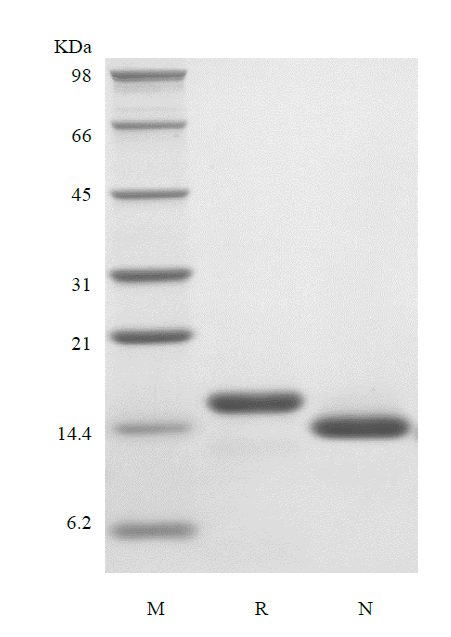- Synonyms
- Hematopoietic Growth Factor, MCGF, Multipotential Colony-stimulating Factor, P-cell-stimulating Factor.
- Source
- Escherichia coli.
- Molecular Weight
- Approximately 16.3 kDa, a single non-glycosylated polypeptide chain containing 144 amino acids.
- AA Sequence
- MISDRGSDAH HLLRTLDCRT IALEILVKLP YPQVSGLNNS DDKANLRNST LRRVNLDEFL KSQEEFDSQD TTDIKSKLQK LKCCIPAAAS DSVLPGVYNK DLDDFKKKLR FYVIHLKDLQ PVSVSRPPQP TSSSDNFRPM TVEC
- Purity
- > 95 % by SDS-PAGE and HPLC analyses.
- Biological Activity
- Fully biologically active when compared to standard. The ED50 as determined by a cell proliferation assay using murine MC-9 cells is less than 10 ng/ml, corresponding to a specific activity of > 1.0 × 105 IU/mg.
- Physical Appearance
- Sterile Filtered White lyophilized (freeze-dried) powder.
- Formulation
- Lyophilized from a 0.2 µm filtered concentrated solution in PBS, pH 7.4.
- Endotoxin
- Less than 1 EU/µg of rRtIL-3β as determined by LAL method.
- Reconstitution
- We recommend that this vial be briefly centrifuged prior to opening to bring the contents to the bottom. Reconstitute in sterile distilled water or aqueous buffer containing 0.1 % BSA to a concentration of 0.1-1.0 mg/mL. Stock solutions should be apportioned into working aliquots and stored at ≤ -20 °C. Further dilutions should be made in appropriate buffered solutions.
- Stability & Storage
- Use a manual defrost freezer and avoid repeated freeze-thaw cycles.
- 12 months from date of receipt, -20 to -70 °C as supplied.
- 1 month, 2 to 8 °C under sterile conditions after reconstitution.
- 3 months, -20 to -70 °C under sterile conditions after reconstitution.
- Usage
- This material is offered by Shanghai PrimeGene Bio-Tech for research, laboratory or further evaluation purposes. NOT FOR HUMAN USE.
- SDS-PAGE

- Reference
- 1. Yang YC, Ciarletta AB, Temple PA, et al. 1986. Cell. 47:3-10.
2. Otsuka T, Miyajima A, Brown N, et al. 1988. J Immunol. 140:2288-95.
3. Cohen DR, Hapel AJ, Young IG. 1986. Nucleic Acids Res. 14:3641-58.
4. Esandi MC, van Someren GD, Bout A, et al. 1998. Gene Ther. 5:778-88.
5. Dorssers L, Burger H, Bot F, et al. 1987. Gene. 55:115-24.
- Background
- Interleukin-3 (IL-3) is a type of biological signal (cytokine) which is encoded by the IL-3 gene located on chromosome 5 and produced primarily by activated T cells beside human thymic epithelial cells, activated murine mast cells, murine keratinocytes and neurons/astrocytes. It exerts its biological activities through binding to Interleukin-3 receptors included α and β subunits, but sequence analysis revealed a number of features indicative of the presence of only one β-subunit in the rat. Interleukin-3 acts in hematopoiesis by controlling the production, differentiation, and function of 2 related white cell populations of the blood, the granulocytes and the monocytes-macrophages. Furthermore, rat and human IL-3 share low homology and have not cross species activity.









 COA Application
COA Application


